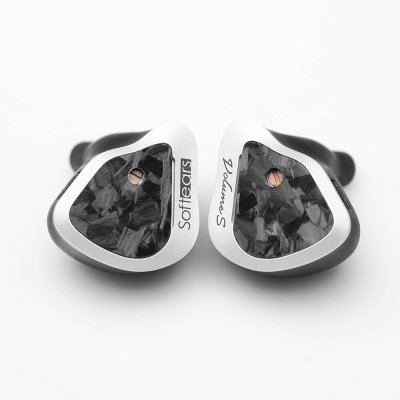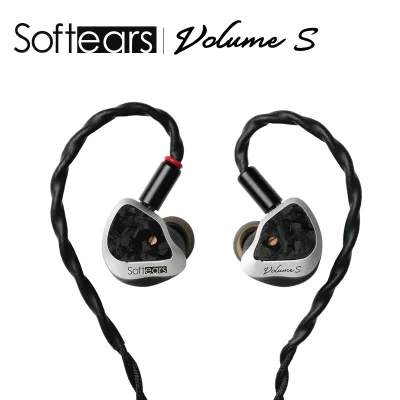Softears Volume S and Elysian Pilgrim use 2DD+2BA and 1DD+3BA driver setups respectively. Softears Volume S costs $320 while Elysian Pilgrim costs $400. Elysian Pilgrim is $80 more expensive. Softears Volume S holds a clear 0.5-point edge in reviewer scores (7.8 vs 7.3). Softears Volume S carries a user score of 8.2. Softears Volume S has better bass with a 0.9-point edge, Softears Volume S has better mids with a 0.9-point edge, Softears Volume S has better treble with a 0.6-point edge, Elysian Pilgrim has significantly better dynamics with a 1.3-point edge, Softears Volume S has significantly better soundstage with a 1-point edge, Elysian Pilgrim has better details with a 0.8-point edge and Elysian Pilgrim has better imaging with a 0.5-point edge.
Insights
| Metric | Softears Volume S | Elysian Pilgrim |
|---|---|---|
| Bass | 8.3 | 7.3 |
| Mids | 7.5 | 6.6 |
| Treble | 7.5 | 6.9 |
| Details | 6.5 | 7.3 |
| Soundstage | 8 | 7 |
| Imaging | 6.5 | 7 |
| Dynamics | 6 | 7.3 |
| Tonality | 7.9 | 7.3 |
| Technicalities | 7.5 | 7.4 |
Softears Volume S Aggregated Review Score
Average Reviewer Scores
Average Reviewer Score:
7.8Strongly Favorable
Elysian Pilgrim Aggregated Review Score
Average Reviewer Scores
Average Reviewer Score:
7.3Generally Favorable
Reviews Comparison
Softears Volume S reviewed by Super* Review
Youtube Video Summary
The Softears Volume S at $320 sets a new tonal benchmark for IEMs in its price range. It arrives in solid packaging featuring a zippered carry case (a bit large but functional), protective earpiece pockets that might feel overkill for some, and two excellent sets of ear tips – including Softears' own highly-regarded Ultra Clear tips. Build quality is generally fantastic, highlighted by a resin shell, a comfortable paracord-style cable with a low-profile, user-swappable termination system, and recessed 2-pin connectors. While the aesthetics might feel a bit old-school to some, the fit is comfortable and stable due to its semi-custom shape and longer nozzle, making it secure enough for sleeping. A small screwdriver-adjustable tuning switch offers a secondary, brighter Harmon-like sound signature, though the default tuning is preferred.
The default sound signature is a warm-tilted neutral, delivering exceptional natural timbre and tasteful bass boost. This bass stands out for its exceptional physicality – punchy and impactful without being overbearing – alongside articulate sub-bass that’s easy to follow. Combined with well-defined transients, particularly in the upper-midrange, it creates a satisfyingly rich and dense presentation. While spatial effects and imaging are competent but not standout, the overall tonality and bass quality are remarkably refined. Comparisons show it offers a better tonal balance and bass control than the bassier Dunu DaVinci, significantly more body and richness than the brighter, thinner Moondrop Blessing 3, and trades blows with the Moondrop Dusk – the Volume S providing superior density and mid-bass presence versus the Dusk's more open, spacious presentation.
Ultimately, the Softears Volume S earns a full five-star rating. It might not be the absolute most technically dazzling IEM, but its fantastic tonal balance, unique bass physicality, and overall refinement make it a compelling choice. For $320, it delivers a sound signature that feels just right – rich, satisfying, and universally appealing – challenging more expensive offerings and establishing itself as a top contender in its class.
Super* Review original ranking
Super* Review Youtube ChannelBuy Softears Volume S on HiFiGO
Ad
Price: $290
Buy Softears Volume S on HiFiGO
Elysian Pilgrim reviewed by Super* Review
Youtube Video Summary
The Elysian Pilgrim brings boutique flair to a more reachable $400 tier with a metal shell that mixes matte and glossy milling, a comfy medium fit, and a plush two-core cable that’s nicer than most in the class. Notable is the Pentaconn connector—smooth to rotate and said to be durable—though cable swapping is less convenient if the stash is mostly 2-pin/MMCX. Accessories feel thoughtful (including unique black-core SpinFit tips), while the case skews a bit large.
Sonically it’s a well-balanced, slightly midrange-focused tuning with a clean sub-bass lift (below ~150 Hz) that can read “bass-light” on tracks heavy in mid-bass. Treble isn’t pushed; presentation comes off a touch brighter/open than the curve suggests, with solid imaging and agreeable vocal clarity. Compared to an earlier show demo, the production unit’s top end feels nerfed: those delicate, Plucky treble transients and the weight in high-hat percussion that once stood out are dialed back for a safer listen.
In the $400 cohort—Yanyin Canon 2 (warm, meaty), Thieaudio Hype 4 (leaner mids, thicker bass), Moondrop Dusk (clinical neutral with sub-bass and forward vocals), and Softears Studio 4 (brightest, most lively)—Pilgrim slots squarely mid-pack: agreeable, but less distinctive than the more characterful peers. Had the show tuning shipped, it would spar closer to the front; as is, the take is competent yet conservative. Final verdict: three stars out of five—a quality set that favors balance over excitement in an increasingly competitive bracket.
Super* Review original ranking
Super* Review Youtube ChannelBuy Elysian Pilgrim on HiFiGO
Ad
Price: $359.10
Buy Elysian Pilgrim on HiFiGO
Softears Volume S reviewed by Jaytiss
Jaytiss Youtube Channel
Elysian Pilgrim reviewed by Jaytiss
Youtube Video Summary
Elysian’s Pilgrim shows up with a small, comfortable shell and a tidy, premium-feeling case—white on the outside, a bit papery inside, but practical. Fit leans shallow; a grippy tip helps keep things steady. The unit measured with excellent channel matching and tracks closely to a preferred target, setting the stage for a confident first impression.
On sound, Pilgrim delivers punchy bass with real note weight and slam, natural mids, and imaging that locks in place. There’s a touch of metallic/lush timbre and an ear-gain region that can feel a bit forward, but the overall tonality stays engaging. It’s not a “baby Annihilator”: the big sibling still brings deeper sub-bass and a cleaner upper register, while Pilgrim feels a little more fun and lively. Versus Hype 4, the two trade blows—late vs. early ear gain—with Hype 4 getting a slight nod for some tastes; against the Mega 5 EST, Pilgrim is the more exciting listen and, at roughly $150 less, the stronger value.
Ranking wise, Pilgrim sits among the best at its price, even sparring with costlier sets, though it stops short of heavy hitters like Grand Maestro, Annihilator, Jupiter, or Velour. Assuming the rumored $350–$450 bracket, the package—sound, cable, and case—is compelling. Minor quirks in the ear-gain area aside, this is an exceptional IEM with a full recommendation, and there’s even a Noir version on the horizon for those curious about variants.
Jaytiss Youtube Channel
Softears Volume S reviewed by Audionotions
Elysian Pilgrim reviewed by Audionotions
Softears Volume S reviewed by Gizaudio Axel
Gizaudio Axel original ranking
Gizaudio Axel Youtube ChannelElysian Pilgrim reviewed by Gizaudio Axel
Gizaudio Axel original ranking
Gizaudio Axel Youtube ChannelSoftears Volume S reviewed by Jays Audio
Youtube Video Summary
The Softears Volume S emerges as a standout vocal specialist under $500, often described as a "mini studio 4“ due to similar frequency graphs. However, it trades some treble detail for superior scaling and a heightened focus on the mid-range, particularly vocals, while adding a touch more mid-bass oomph. This treble reduction allows the music to breathe, creating a more immersive and musical experience that pulls the listener deeper into the sound compared to the Studio 4, without sacrificing a sense of space or leaving the bass and treble feeling inadequate. Though not bass-heavy or treble-head oriented, the low-end provides enough thump and the highs enough air to avoid sounding lean or dark, resulting in a presentation that's slightly less technical and balanced than the Studio 4 but excels in vocal delivery and engagement.
A key feature is the tuning switch which boosts upper mids and treble while lowering the bass, effectively transforming the sound into a cleaner, more technical version of Harman 2019, even surpassing the Studio 4 in detail retrieval in this mode. However, this boosted configuration can sound shouty, lean, and overly clinical for many preferences, lacking the thickness of the stock tuning and scaling less effectively at higher volumes. The stock tuning, preferred for its vocal prowess, truly comes alive with increased volume. The included clear tips are recommended for a slight treble lift and comfort, and the bundled USBC adapter adds a subtle amount of sub-bass rumble, though the low-end remains clean and controlled, reminiscent of leaner sets like the Pilgrim, not providing heavy slam.
While the Studio 4 remains a solid, well-balanced all-rounder, especially on sale around $350, and alternatives like the EM10 (more detailed), Supermix 4 (better value), the Volume S carves its niche with exceptional vocal performance at higher volumes using the stock tuning. Its main drawbacks involve the confusing switch design (requiring opposite positions on each earpiece for the same tuning with no clear indicators) and the pricing debate; using non-branded drivers suggests a more appropriate price point would be $200-$250 rather than $300. Despite these quirks and marketing claims about the passive radiator's role (its actual impact being debatable), the Volume S delivers a great sounding, flexible IEM offering distinct sonic profiles based on volume level and switch position.
Jays Audio Youtube Channel
Elysian Pilgrim reviewed by Jays Audio
Youtube Video Summary
Hyped for good reason, Elysian’s Pilgrim pairs a sleek, carved metal shell with a genuinely upgraded cable and a refined, clean-balanced tuning. Technicals punch high for the price—resolution sits a notch above sets like Hype 4 and Dusk, while the bass shows tight texture, tidy decay, and neat separation. The low end isn’t as forward or “full” as Hype 4, trading slam for a more neutral and organized presentation that suits listeners seeking clarity over thump.
Vocals are naturally placed: not shouty, not distant, with a touch of air on the tail that avoids harshness. Compared with Dusk, the Pilgrim carries better upper-mid extension and a more complete, detailed midrange; it’s also a bit smoother and more natural up top, and adds a hair more sub-bass for engagement. As a package—sound, build, and unboxing—the Pilgrim reads like a polished, modernized take on that classic balanced recipe.
Context matters, though. As an all-rounder around $300–$400, Pilgrim would be an easy pick, but the Supermix 4 at ~$150 offers roughly “90% of the experience” with an even smoother tilt, pressuring its value case. On the horizon, Simgot EM10—if priced around $399–$450—promises more air, detail, punchier mid-bass, and a wider wrap-around stage, potentially overshadowing Pilgrim’s more chill, laid-back vibe. Practical notes: no obvious channel imbalance was heard, but the ring plating can scratch quickly, the fit is a bit shallow, and wider-bore tips help. Net: a beautifully made, balanced performer for those who value refinement and design, but with fierce competition today, some shoppers may prefer to wait or choose something more specialized (e.g., Hype 4 for bigger low-end).
Jays Audio Youtube Channel
Softears Volume S reviewed by Z-Reviews
Youtube Video Summary
The Softears Volume S offers a dramatic transformation through its impedance switch, requiring a tiny screwdriver to toggle between low (9.8 ohm) and high (31.2 ohm) modes. The low impedance mode is described as painfully clinical, bland, and annoyingly sterile across all tested amplifiers. It’s reminiscent of the disliked original Volume model, lacking any enjoyable tuning despite EQ attempts. This mode only suits listeners craving absolute neutrality, offering little musical engagement.
Switching to the high impedance mode completely revolutionizes the experience. It becomes relaxed, unoffensive, and remarkably smooth, with notes possessing a lingering, church-like resonance that adds emotional depth. This mode presents music with a spacious, uplifting quality and a subtle chest-felt pressure during resonant passages. However, it demands quality amplification to shine and benefits from tip-rolling; the included sticky liquid silicone tips enhance the signature, though alternatives like Azla SednaEarfit can tweak the response. Comfort and build are excellent, though the fabric cable exhibits some microphonics.
Priced around $300, the Volume S earns a cautious recommendation primarily for its stellar high-impedance performance. It requires tinkering with tips and sources to reach its potential and faces stiff competition in its price bracket. While not an outright class leader, it’s a significant upgrade over the original Volume. The package includes a luxurious case, multiple tips, and a branded USB-C adapter, reflecting Softears' typical attention to detail. Just keep it locked in high-impedance mode.
Z-Reviews Youtube Channel
Elysian Pilgrim reviewed by Z-Reviews
2025-07-17Youtube Video Summary
Elysian Pilgrim hits the rare $400 bracket with a hybrid recipe—1× LSR dynamic and 3× Sonion BA—and a presentation that pulls the stage in. Instead of big, floaty width, the image clamps down with laser focus: vocals and transients sit right there, almost “under the skin.” Well-recorded tracks pop with mic-placement clarity; poorly recorded ones get called out instantly. Bass is punchy and structurally correct rather than boosted—not a basshead set, but it thumps when the mix calls for it. It scales across amps (from clean to tubey), with some chains teasing a bit more soundstage while keeping that intimate, hyper-detailed character.
Build is slick: a comfortable, not-too-thick shell with a machined aluminum back and proper venting. The star quirk is the Pentaconn Ear connector—rotational like MMCX but far more robust—which also means most existing cables won’t fit, so the stock cable (often 4.4 mm, with 3.5 mm or both for extra) becomes the default. The earhooks curve a bit aggressively but can be reshaped; comfort overall is easy listening. Accessories are fine but not lavish: SpinFit tips and a big showpiece case that’s cool, if not pocketable.
Sonically it’s a “punch-drunk focus” specialist: drives through track after track, rewards great recordings, and refuses to sugarcoat weak ones. The Pilgrim feels special because of that concentrated energy and neutral-honest bass—more “truth serum” than lounge lizard. Verdict: 9/10. Docked for cable ecosystem quirks and a modest accessory spread, but the sound is compelling enough to make that nitpicking feel small. Curiosity about the pricier Pilgrim Noir stays high, yet this standard model already delivers a distinctive, addictive ride.
Z-Reviews Youtube Channel
Softears Volume S reviewed by Tim Tuned
Youtube Video Summary
The Softears Volume S delivers a distinctly colored sound signature with significant boosts in two key areas: the bass and the upper mid-range. Its bass profile is uniquely elevated up to around 300Hz, resulting in a physical, heavy, yet well-defined low end that impresses with substantial note weight and attack, appealing even to bass enthusiasts. Vocals cut through clearly due to the upper mid-range boost, but this tuning comes with a trade-off: a noticeable sense of hollowness and a narrower soundstage that can feel congested on certain tracks, creating a love-hate relationship with its presentation.
The treble offers a safe, natural, and polite character, providing adequate detail without excessive brightness or roll-off, though it may lack sparkle for some listeners. Technically, the Volume S performs at a level comparable to the Moondrop Blessing 3, excelling particularly in the incisive attack and substantial weight behind each note. When compared to competitors, the Volume S edges out the Tea Pro in bass quality, separation, and natural timbre, though the Tea Pro offers a wider stage. Against the Blessing 3, the Volume S trades openness and cleanliness for a more fun, bass-forward and impactful experience. It also presents a more balanced signature than the brighter, more treble-focused Kiwi Ears Astral.
Ultimately earning an A-minus rating, the Volume S is highly recommended for those seeking exceptional bass quality and a fun, colored tuning. However, it might not suit listeners prioritizing a wide soundstage, a neutral signature, or a bright, sparkly treble with forward micro-details; these listeners are advised to audition first.
Tim Tuned Youtube Channel
Elysian Pilgrim reviewed by Tim Tuned
Youtube Video Summary
Elysian Pilgrim hits that rare sweet spot: a truly affordable entry into the brand’s house sound that still feels flagship-adjacent. Think Gaia DNA with a more tamed signature—the bass is dynamic, punchy, thumpy yet modest in quantity, staying clean with no bleed into the lower mids. Vocals sit center-stage with a touch of thickness, generally natural timbre and only a hint of grain that comes from the energetic top end. It’s a balanced, non-boomy low end for everyday listening; bassheads may want +1–2 dB more.
The star is the treble: incisive, nuanced, and genuinely “end-game” in detail retrieval at this price. Treble quality tracks closely with Gaia, still shy of the Annihilator, but astonishing for $399. Overall technical performance is the wow factor—notes feel crisp, tactile, high-definition, sitting well above sets like the Blessing 3 while only lightly trading away smoothness, and doing so tastefully. It reads as a “high-res” listen without slipping into harshness.
Against peers: Studio 4 stays smoother and more natural, but Pilgrim brings more energy and clearly higher detail. Versus the Hype 4, the latter has more bass quantity, yet Pilgrim wins in treble timbre and overall resolution. Compared with Moondrop x Crinacle Dusk, rankings shake out with Pilgrim first in treble and technicals, while the DSP Dusk often leads for bass/vocals over the analog version. Verdict: a big green thumbs up—an A+ for delivering thrilling, highly technical performance that competes above its class. (Interview notes: the Pilgrim Noir variant aims warmer, includes an Eros S cable and luxe case at a higher price, while standard Pilgrim stays the brighter, value-focused pick.)
Tim Tuned Youtube Channel
Softears Volume S reviewed by Smirk Audio
Elysian Pilgrim reviewed by Smirk Audio
Softears Volume S reviewed by Head-Fi.org
Elysian Pilgrim reviewed by Head-Fi.org
Softears Volume S (more reviews)
Softears Volume S reviewed by Audio Amigo
Youtube Video Summary
Softears Volume S follows the 2022 Volume and steps into a fiercely competitive ~$320 bracket with a seriously premium kit: a gorgeous leather case, modular screw-on terminations, both standard and Ultra Clear eartips, IM booties, and tiny screwdrivers for the on-board potentiometer. The stealthy black resin shells with exposed carbon-fiber faceplates feel solid and fit well thanks to slim nozzles; just note there’s no nozzle mesh. The big caveat is the cloth-sheathed stock cable—ergonomically nice but with heavy microphonics. Two tunings are selectable: low-impedance (≈10Ω) and high-impedance (≈31Ω). The low-impedance mode is the keeper; it’s easy to drive yet sensitive to source output impedance, so a dongle under 1Ω is recommended to avoid unintentionally shifting the tonality.
In low-impedance mode the signature is neutral-natural, a flatter, more mid-centric take on “new-meta.” Bass offers quality over quantity: textured, punchy, and responsive without tipping into basshead territory. The mids are the star—clean, warm-tinged lower mids give male vocals body while female vocals sit forward without shout, keeping timbre natural. Treble is smooth, airy, and non-fatiguing, avoiding metallic glare while preserving sparkle. Technical performance is confidently above average for the price: imaging & stage feel wide and well-layered, with good separation and resolution that rewards attentive listening without forcing it.
Positionally, think “Kato upgrade”: smoother treble, better bass texture, and a refinement that many will prefer. Versus spicier rivals like DaVinci, Project Meta, Dusk DSP, or Mega 5 EST, the Volume S sounds more controlled and “correct,” trading some slam and upper-air fireworks for coherence and timbre. It won’t thrill bass lovers, treble heads, or detail chasers seeking a spotlighted presentation; everyone else gets a superb all-rounder that feels benchmark-worthy—the HD600/650 vibe for IEMs. Verdict: you should buy this if a do-it-all, neutral-natural tuning is the goal; just mind your source impedance and consider swapping the cable to kill the microphonics.
Audio Amigo Youtube Channel
Softears Volume S reviewed by
 Fresh Reviews
Fresh Reviews
Youtube Video Summary
The Softears Volume S delivers a fantastic hybrid sound in its low impedance mode, characterized as a warm neutral tuning with a lush note weight, good bass punch without bloat, and a slight upper-midrange emphasis that makes vocals pop. This signature translates exceptionally well across both music listening and competitive gaming, offering great separation, layering, and phenomenal imaging for precise positional awareness. While engaging and non-fatiguing, gunfire and intense effects in games like Apex Legends can sometimes feel on the verge of shouty or slightly occlusive during chaotic, high-level scenarios, lacking that last bit of air and resolution in the upper mids.
Gaming performance shines across multiple titles. The Volume S provides outstanding depth perception and accurate imaging for Apex Legends slides and light footsteps, excels in Valorant with its separation and verticality, handles the chaos of Call of Duty exceptionally well, and proves to be a top recommendation for Fragpunk due to its loud, precise, and easily trackable footsteps. The smaller resin chassis offers great comfort and ergonomics, especially for those struggling with fit, though it doesn't feel quite as premium as some metal competitors in its price range.
Significant drawbacks include the utterly dismissed high impedance mode tuning, deemed "absolute garbage" and a headache for gaming, and the fragile tuning mechanism itself, prone to easy damage. The included shoelace-style cable is functional with a removable termination but not a favorite, and the unboxing experience, while decent with a pleather case, extra termination, and two sets of silicone tips, is fairly typical for the price. Ultimately, the Softears Volume S stands as a killer all-around IEM when locked into its excellent low impedance mode, highly recommended for its crossover appeal despite the useless tuning switch and build quibbles.
Fresh Reviews original ranking
Fresh Reviews Youtube ChannelSoftears Volume S Details
Driver Configuration: 2DD+2BA
Tuning Type: Neutral with Bass Boost
Brand: Softears Top Softears IEMs
Price (Msrp): $320
Support our free service! Buying through our affiliate links costs you nothing extra:
Elysian Pilgrim Details
Driver Configuration: 1DD+3BA
Tuning Type: U-Shaped
Brand: Elysian Top Elysian IEMs
Price (Msrp): $400
Support our free service! Buying through our affiliate links costs you nothing extra:
Softears Volume S User Review Score
Average User Scores
Average User Score:
Based on 2 user reviews
8.2Very Positive
Elysian Pilgrim User Review Score
Average User Scores
Average User Score: n/a
Based on 0 user reviews
No user reviews yet. Be the first one who writes a review!
Softears Volume S Gaming Score

Gaming Score & Grade
- The gaming score is prioritizing technical capabilities of the IEM (Separation, Layering, Soundstage) and good value.
Gaming Score
8.4Gaming Grade
A+Elysian Pilgrim Gaming Score

Gaming Score & Grade
- The gaming score is prioritizing technical capabilities of the IEM (Separation, Layering, Soundstage) and good value.
Gaming Score
7.1Gaming Grade
A-Softears Volume S Scorings
Average Technical & Tuning Grades
Average Tunign Grade
A- Tuning feels well executed, keeping a natural flow across the spectrum. Switching genres feels seamless.
Average Technical Grade
A- You get a well-rounded technical package that keeps separation, detail, and staging in harmony. It's a solid middle ground between fun and fidelity.
Elysian Pilgrim Scorings
Average Technical & Tuning Grades
Average Tunign Grade
A-- It balances warmth and clarity well, showing only minor quirks along the way. Timbre feels believable with most instruments.
Average Technical Grade
A-- A competent technical showing keeps separation intact while delivering modest staging. It feels tidy even when recordings stack layers.
Softears Volume S User Reviews
Share your experience and build your personal ranking list.
You need to be signed in to write your own reviewA well-rounded, coherent IEM that shines in low-impedance tuning with excellent midrange clarity.
Pros
Balanced, natural midrange with solid bass and rich accessories.Cons
High-impedance mode feels unnecessary and shells may be bulky for small ears.RSV with more bass quantity and better quality, at less than half the price.
Pros
Very nicely balanced sound signature for all-rounder duties, with tonality and technical performance that punches above its price. More even sub - mid bass profile which results in a more cohesive, better textured bass vs harman/meta tuned sets.Cons
Pinna gain isn't an ideal fit for my HRTF, hearing slightly too much upper-mid emphasis after extended listening and comparisons. Upper treble is lacking air vs more expensive sets, most evident in cymbal hits coming across dulled, not unlike the RSVElysian Pilgrim User Reviews
"This is an example review"
Pros
- Example pro 1
- Example pro 2
Cons
- Example con 1
- Example con 2
Share your experience and build your personal ranking list.
You need to be signed in to write your own reviewFind your next IEM:
IEM Finder Quiz
newIEM Comparison Tool
newVS




























